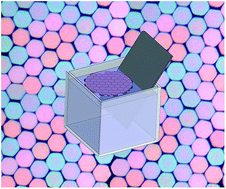Self-assembly of microscopic tablets within polymeric thin films: a possible pathway towards new hybrid materials
Abstract
Self-assembly produces materials with highly organized microstructures and attractive properties for a variety of applications. Self-assembly is a process which typically involves molecules or nano-scale objects, with only a few reports of successful self-assembly of objects with larger dimensions (greater than 1 μm). Self-assembly at this length scale is however important, and may find different technological applications because of the possibility to incorporate different functionalities to the building blocks by for example lithographic and microfabrication techniques. Meso-scale self-assembly is also particularly promising to duplicate the structure of natural materials such as nacre (mother of pearl). Here, we fabricated 10 μm sized hexagonal tablets of silicon which self-assembled into a well-packed periodically arranged structure at a water–air interface. The microstructure was secured in a PDMS thin film, which made it stable and more organized compared to the similar large scale assemblies reported in the past. The self-assembled films can serve as building blocks for biomimetic materials, protective coatings, flexible electronics, or tunable optical devices.


 Please wait while we load your content...
Please wait while we load your content...